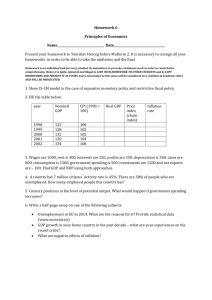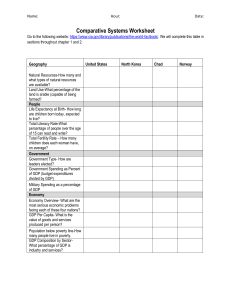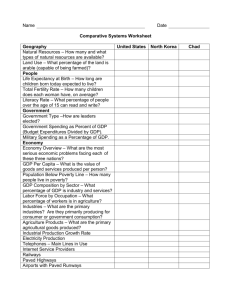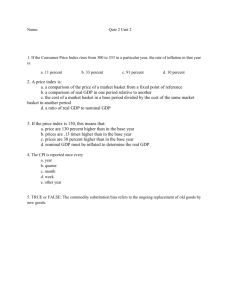No - Bank Indonesia
advertisement
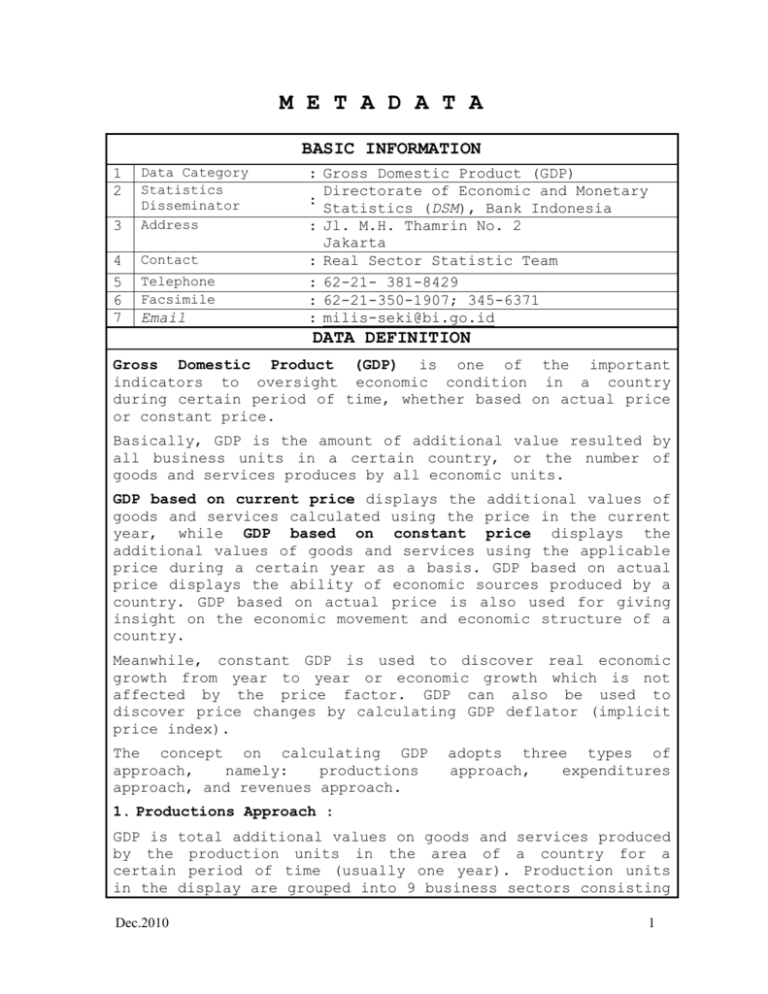
M E T A D A T A BASIC INFORMATION 1 2 3 4 5 6 7 Data Category Statistics Disseminator Address Contact Telephone Facsimile Email : Gross Domestic Product (GDP) Directorate of Economic and Monetary : Statistics (DSM), Bank Indonesia : Jl. M.H. Thamrin No. 2 Jakarta : Real Sector Statistic Team : 62-21- 381-8429 : 62-21-350-1907; 345-6371 : milis-seki@bi.go.id DATA DEFINITION Gross Domestic Product (GDP) is one of the important indicators to oversight economic condition in a country during certain period of time, whether based on actual price or constant price. Basically, GDP is the amount of additional value resulted by all business units in a certain country, or the number of goods and services produces by all economic units. GDP based on current price displays the additional values of goods and services calculated using the price in the current year, while GDP based on constant price displays the additional values of goods and services using the applicable price during a certain year as a basis. GDP based on actual price displays the ability of economic sources produced by a country. GDP based on actual price is also used for giving insight on the economic movement and economic structure of a country. Meanwhile, constant GDP is used to discover real economic growth from year to year or economic growth which is not affected by the price factor. GDP can also be used to discover price changes by calculating GDP deflator (implicit price index). The concept on calculating GDP approach, namely: productions approach, and revenues approach. adopts three types of approach, expenditures 1. Productions Approach : GDP is total additional values on goods and services produced by the production units in the area of a country for a certain period of time (usually one year). Production units in the display are grouped into 9 business sectors consisting Dec.2010 1 of: (1) Agriculture, Livestock, Forestry, and Fishery; (2) Mining and Quarrying; (3) Manufacturing Industry; (4) Electricity, Gas & Sanitary Water; (5) Construction; (6) Trading, Hotel & Restaurant; (7) Transportation and Communication; (8) Finance, Real Estate and Company Services; and (9) Services (including government services). 2. Expenditures Approach : GDP is all components of final inquiries consisting of: (1) Household consumption and non-provit private institution expenditures, (2) Government consumption, (3) Gross domestic fixed capital formations, (4) Inventory alteration, and (5) Net export (export subtracted by import). 3. Revenues Approach : GDP is amount of reward received by production factors for participating in the production process of a certain country during certain period of time (usually one year). The production factor reward is fees and salaries, land leasing, capital interest, and profit; all of which has not been deducted by income tax or any other direct taxes. Within this definition, GDP also includes all depreciation and net indirect taxes (indirect taxes subtracted by subsidy). The Gross National Product (GNP) is GDP added by net foreign income. Net foreign income is income out of production factors (human resources and capital) earned by an Indonesian resident from foreign countries subtracted by the same income earned by a foreigner in Indonesia. National Income is GNP deducted by indirect net taxes (net) and depreciation. Net indirect taxes government subsidy. are indirect taxes subtracted by Implicit Price Index of GDP is a ratio between GDP’ actual price and GDP’ constant price. GDP deflator is the GDP implicit price index growth rate. Exporting and importing goods is goods and services transaction occurred between Indonesian residents and foreign residents. DATA COVERAGE Dec.2010 2 Coverage: GDP based on business sectors categorized into 9 economic sectors according to the International Standard Industrial Classification (ISIC) as follows: 1. Agriculture, Livestock, Forestry, and Fishery a. Food Crops b. Estate Crops c. Livestock and Its Product d. Forestry e. Fishery. 2. Mining and Quarrying a. Oil and Gas Mining b. Non-Oil and Gas Mining c. Quarrying. 3. Manufacturing Industry a. Oil and Gas Manufacturing Industry - Petroleum Refinery - Liquefied Natural Gas (LNG) b. Non-oil and gas industry - Food, Beverages and Tobacco Industries - Textile, Leather Products and Footwear Industries - Wood and Other Products Industries - Paper and Printing Products Industries - Fertilizers, Chemical and Rubber Products Industries - Cement, and Non-Metalic Quarrying Products Industries - Iron and Steel Basic Metal Industries - Transport Equipment, Machinery & Apparatus Industries - Other Manufacturing Products Industries 4. Electricity, Gas & Water Supply a. Electricity b. City Gas c. Water Supply. 5. Construction 6. Trading, Hotel and Restaurant a. Wholesale and Retail Trade b. Hotels Dec.2010 3 c. Restaurants. 7. Transportation and Communication a. Transportation - Railway transportation - Road transportation - Sea transportation - River, lake and ferry transportation - Air transportation - Services Allied to transportation b. Communication. 8. Financial, Real Estate and Business Services a. Bank b. Non-Bank Financial Institution c. Services Allied to Finance d. Real Estate e. Business Services. 9. Services a. General Government - Government Administration and Defense - Other Government Services. b. Private - Social and Community Services - Amusement and Recreational Services - Personal and Household Services. Meanwhile, GDP based on the usage categorized into 6 components, namely: 1. Household Consumption Expenditures covers all expenditure for goods and services consumption subtracted by net secondhand and waste goods selling carried out by the household in one year. 2. Government Consumption Expenditures, covers expenditure for civil servants spending, depreciation and goods spending, either central government or regional government, excluded the income from goods and services produced. This data using the realization of State Budget (APBN) figures. 3. Establishment of Gross Domestic Fixed Capital covers production and purchasing of new domestic capital goods and Dec.2010 4 used goods or new foreign capital goods. The method used is flow of goods approach. 4. Inventory alteration. The changes of the stock is counted from additional of gross value added of GDP all sector subtracted by other final demand components 5. Export of Goods and Services. Export of goods is counted according to free on board (fob) price. 6. Import of Goods and Services. import of goods is counted based on Cost Insurance and Freight (CIF) Unit: Data disseminated in billions of. Currency: IDR PERIODICITY OF PUBLICATION Quarterly TIMELINESS 6 (six) weeks after the end of the reference month (website). 7 (seven) weeks after the end of the reference month (CD and printed matter). ADVANCE RELEASE CALENDAR (ARC) ARC (attached) will be disclosed every year by December. SOURCE OF DATA Statistics Indonesia (Badan Pusat Statistik/BPS) : Survei Khusus Triwulanan (SKT) of institutions and companies, Survei Khusus Tabungan dan Investasi Rumah tangga (SKTIR), Economic census, Survei Sosial Ekonomi Nasional (Susenas), Yearly census for middle/upper scale business, Census for small scale business, Income and Expenditures State Budget (APBN), Adhoc surveys and Consumer Prince Index & Wholesale Price Index figures. The export of goods data acquired from Statistics Indonesia annual publication, whereas the export of services acquired from Balance of Payment, published by Bank Indonesia. METHODOLOGY Currently, calculated Dec.2010 GDP data published by Statistics Indonesia using production approach and expenditure 5 approach. Data compilation for GDP is conducted as follows : - For Sectoral GDP, data are compiled from related departments/institutions. The data compiled from each sector consists of production data, data on prices at producer level, investment’ production cost, and expenditure data acquired either from survey or estimation. - For Expenditure GDP, data are compiled by related departments/institutions that officially issued the data (such as export-import, government expenditures and investment, and private investment), also through special surveys (such as household expenses special survey). Detailed explanation on compiling method on GDP data can be acquired on the Annual Publication of Indonesian National Income, Statistics Indonesia. Compilation technique used is: a. The data for each sector which is calculated in each related working unit at Statistics Indonesia is delivered afterwards to the Directorate of Productive Balance Sheet and Directorate of Consumption Balance Sheet (Statistics Indonesia) to be consolidated and estimated. b. The calculation for the GDP for each sector has different characteristic as referred in the explanation of calculating method of GDP in the annual publication of Statistics Indonesia National Income. The Revision on the base year for GDP constant price’ calculation is conducted periodically (1960, 1973, 1983, 1993, dan 2000). Since 2004, GDP data provided have been used 2000 as base year covering data since quarter I-2000 period. The changes of 1993 base year to 2000 is conducted because the structure of Indonesia’ economy has undergone major transformation, covers the fluctuation of price, the scope of both production and consumption commodities, also types and quality of goods and services produced. DATA INTEGRITY During the issuance time of quarterly GDP, the data are very very preliminary (***). The data turn into very preliminary Dec.2010 6 (**) after the quarterly data is completed for one calendar year. The data became preliminary (*) after one year, commencing from the end of reference year. The final status of the data is implied in the publications by the lack of a symbol indicating that the data are provisional, which takes about two years after the end of reference year. Major changes on GDP methodology, which is usually announced in Statistics Indonesia annual publication titled ”Indonesian National Income”, are noted along the data with the new methodology published for the first time. PUBLIC ACCESS TO DATA Data are disseminated on: BI’s Website http://www.bi.go.id/web/en/Statistik/Statistik+Ekonomi+dan+K euangan+Indonesia/Versi+HTML/Sektor+Riil/ Indonesian Financial Statistics (Statistik Ekonomi dan Keuangan Indonesia/SEKI)) Publication (CD and printed matter). Data can also be acquired from: Statistics Indonesia’s Website http://dds.bps.go.id/eng/aboutus.php?tabel=1&id_subyek=11 Indonesia‘s National Summary Data Page (SDDS Website) - NSDP http://www.bi.go.id/sdds/series/NA/index_pdb.htm Dec.2010 7

